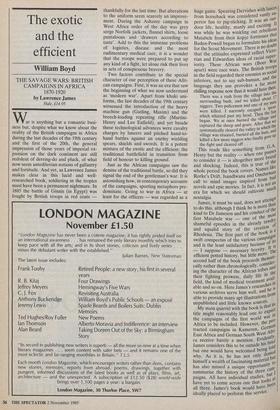The exotic and the efficient
William Boyd
THE SAVAGE WARS: BRITISH CAMPAIGNS IN AFRICA 1870-1920 by Lawrence James
Hale, £14.95
r is anything but a romantic busi- Wa ness but, despite what we know about the reality of the British campaigns in Africa during the last decades of the 19th century and the first of the 20th, the general impression of those years of imperial ex- pansion on the dark continent are still redolent of derring-do and pluck, of what now seem antediluvian notions of gallantry and fortitude. And yet, as. Lawrence James makes clear in this lucid and well- researched book, soldiering in the tropics must have been a permanent nightmare. In 1885 the battle of Ginnis (in Egypt) was fought by British troops in red coats — thankfully for the last time. But alterations to the uniform seem scarcely an improve- ment. During the Ashante campaign in West Africa order of the day was grey serge Norfolk jackets, flannel shirts, loose pantaloons and 'drawers according to taste'. Add to this the immense problems of logistics, disease and the most rudimentary medical care, it is a wonder that the troops were prepared to put up any kind of a fight, let alone risk their lives in acts of conspicuous bravery.
Two factors contribute to the special character of our perception of these Afri- can campaigns. First, it was an era that saw the beginning of what we now understand as 'modern war'. Apart from khaki uni- forms, the last decades of the 19th century witnessed the introduction of the heavy machine gun (Gatling, Maxim) and the breech-loading repeating rifle (Martini- Henry and Lee Enfield), and yet beside these technological advances were cavalry charges by lancers and pitched hand-to- hand battles against an enemy wielding spears, shields and swords. It is a potent mixture of the exotic and the efficient: the traditional battlefield in transition from field of honour to killing ground.
Just as the African campaigns saw the demise of the traditional battle, so did they signal the end of the gentleman's war. It is astonishing how, in contemporary accounts of the campaigns, sporting metaphors pre- dominate. Going to war in Africa — at least for the officers — was regarded as a huge game. Spearing Dervishes with lances from horseback was considered vastly su- perior fun to pig-sticking. It was an out- door life, healthy, manly and exciting. It was while he was winkling out rebellious Matabele from their kopje fortresses that Baden-Powell began to formulate his ideas for the Scout Movement. There is no doubt that the attitudes expressed reflect Victo- rian and Edwardian ideas of racial super- iority. These African wars (Boer War apart) were race wars. The British troops in the field regarded their enemies as social inferiors, not to say sub-human, and the language they use provokes a far more chilling response now than it would have the There was a rush from the village into alf surrounding bush, and we killed about 19 niggers. Two policemen and one of my men were killed. I narrowly escaped a speara ' which whizzed past my head. Then the fa, began. We at once burned the village an captured the sheep and goats. Aft erh th whichthe, village was situated, burned all the huts, U an' killed a few more niggers who finally gave the fight and cleared off • • This reads like something from G.A. P Henty but the reality — when one pauses, to consider it — is altogether more brutal and shocking. Indeed, this is true of the whole period the book covers. Names like Rorke's Drift, Isandlwana and Omdurman, call to mind images inspired from ban novels and epic movies. In fact, it is not art era for which we should cultivate much nostalgia. James, it must be said, does not attempt to do this, although I think he is more than kind to Dr Jameson and his conduct of the first Matabele war — one of the most shameful episodes in the already tawilq and squalid story of the creation 0' Rhodesia. The first part of the book is a swift conspectus of the various campaies and is the least satisfactory because of Its — I suppose — necessary brevity. Let ls efficient potted history, but little more second half of the book proceeds themati- cally rather than chronologically, consider; ing the character of the African tribes an their fighting prowess, daily life in tlf field, the kind of medical treatment avt, able and so on. Here James's researches various archives serve him well, and he is able to provide many apt illustrations from unpublished and little known sources. My main quarrel with the book is that itst title might reasonably lead one to exPeFf, the campaigns of the first world war ,1- Africa to be included. However, the tracted campaigns in Karnerun, Germ East Africa and German South West A1: ca receive barely a mention. Evident' James considers this to be outside his briWeci but one would have welcomed being IA why. As it is, he has not only dellieut himself a wealth of fascinating material bu has also missed a unique opportunityto summarise the histo of the three cat' paigns. All have indivry idual studies, but , have yet to come across one that looks a' all three. James's book would have been ideally placed to perform this service.






















































 Previous page
Previous page